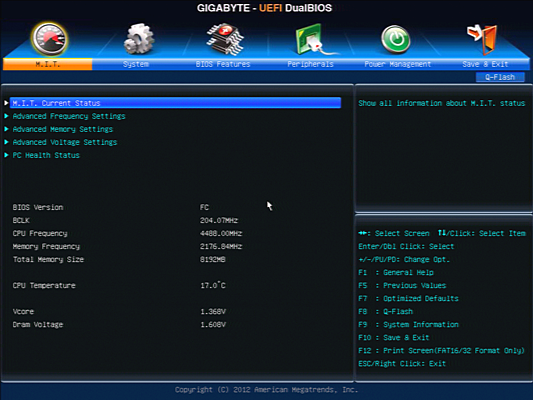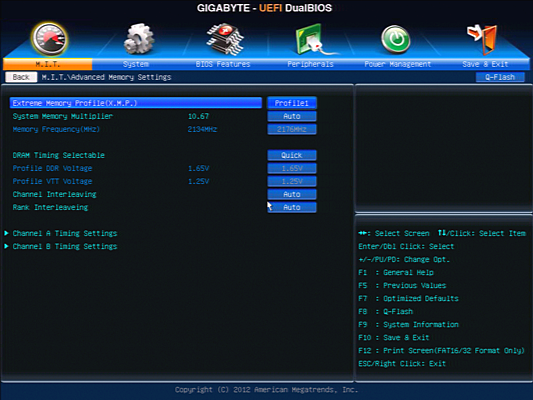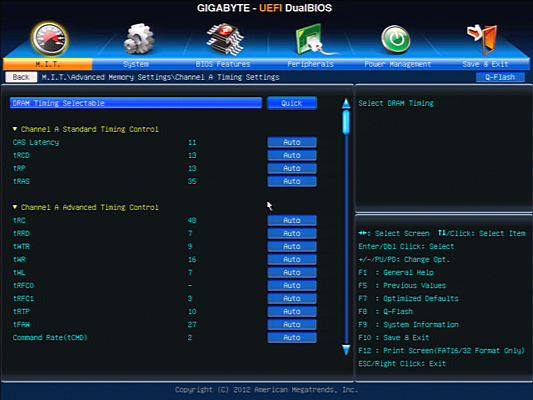Three AMD 990FX-Based Motherboards For Enthusiasts
AMD’s flagship FX-series processors squarely target enthusiasts with sub-$1,000 system budgets, and it's hard to get there with an expensive motherboard. We requested every vendor's top-value solution, and received three boards for your consideration.
990FXA-UD3 Firmware
Gigabyte’s Motherboard Intelligent Tweaker menu opens to display vital component statistics, while several submenus allow actual adjustment.
The Advanced Frequency Settings submenu provides base clock and multiplier controls, including core multiplier, northbridge multiplier, DRAM multiplier, and HT Link frequency. Unfortunately, we found that the board does not block out invalid CPU northbridge ratios, such as those below the DRAM data rate. Additionally, with northbridge ratios spaced exclusively at 200 MHz intervals and DRAM ratios spaced at 266.6 MHz, few of the ratios are identical.
Furthermore, the board lacks any DDR3-2400 ratio. If, for example, you want to set DDR3-2400 by increasing base clock at the DDR3-2133 ratio, you’ll need to start out with a northbridge ratio for 2,200 MHz, a reference clock of 225 MHz, and hope that the resulting 2,475 MHz CPU northbridge frequency doesn’t crash the processor. In our case, it does.
The Advanced Memory Settings submenu provides a redundant memory multiplier control that, like the one in Advanced Frequency Settings, is selectable to match Intel XMP settings. Below that, setting DRAM Timing Selectable to Quick provides linked timing adjustments, while setting it to Expert mode allows per-channel timing manipulation.
Primary and secondary timings are individually adjustable or left in automatic mode, which is tied to the chosen DRAM configuration (XMP or SPD).
A simplified voltage menu gives users access to CPU core, CPU NB core, DRAM, HT Link, PCIe, PLL, and 990FX voltage levels. We found that Regular Vcore Loadline Calibration kept our CPU voltage consistent through shifting load levels, and that a DRAM voltage of 1.615 V corresponded to a meter reading of 1.650 V.
Get Tom's Hardware's best news and in-depth reviews, straight to your inbox.
Current page: 990FXA-UD3 Firmware
Prev Page 990FXA-UD3 Software Next Page Test Settings And Benchmarks-
designasaurus "if we diminished most of those power differences by not installing Asus' power management software at default settings, the company would have likely matched the performance of Gigabyte and ASRock."Reply
Don't speculate! Do the tests and add it to the article so we can see what the software packages are actually accomplishing! That's why I read your site, yeah? For hard info that I can't get myself. -
bgunner designasaurus"if we diminished most of those power differences by not installing Asus' power management software at default settings, the company would have likely matched the performance of Gigabyte and ASRock."Don't speculate! Do the tests and add it to the article so we can see what the software packages are actually accomplishing! That's why I read your site, yeah? For hard info that I can't get myself.I totally agree with this statement. The test should have been done and added into the article because this would of been a good representative of the value of the software. I would like to know for a fact if the software was a hindrance to the electrical efficiency of the Asus and Gigabye boards.Reply -
Crashman bgunnerI totally agree with this statement. The test should have been done and added into the article because this would of been a good representative of the value of the software. I would like to know for a fact if the software was a hindrance to the electrical efficiency of the Asus and Gigabye boards.At least the power was measured and mentioned, even if it didn't get into the chart.Reply
-
bit_user AMD's 890FX was an excellent low-cost server platform, in its day. Great I/O, tons of PCIe lanes, 6-channel SATA3, and ECC support. All with boards and CPUs in the desktop price range that were close to being performance competitive with Intel (when they were introduced, at least).Reply
Now, AMD is just slipping too far behind. Not just on the CPU front, but like how about some PCIe 3?
I'm waiting for 64-bit ARMs to hit the desktop. That's probably the next truly interesting thing on the horizon.
-
boulbox Reply10596062 said:Aren't the 990FX chipsets kind old?
Yes, but not a lot of new things need to be offered anyways. PCIe 3.0 is just a gimmick and doesn't really give much more performance over PCIe2 -
Crashman falchardAren't the 990FX chipsets kind old?990FX is AMD's current "high-end" chipset for enthusiast-level desktops. AMD occasionally releases new chips (look last fall) and motherboard companies keep updating their selection of products.Reply
Old chipset, recent boards, any questions?
-
darkchazz "Three AMD 990FX-Based Motherboards For Enthusiasts"Reply
I don't think enthusiasts would want to buy a slow CPU from AMD. -
Onus What did I miss? The ASRock has better features, including 3-way SLI, more USB3.0, an abundance of accessories, uses less power (the only positive efficiency), has higher performance, lower VRM temps; but BOTH of the other two got awards? I noted the comment about fluctuating prices, but on features alone ASRock looks like the winner. Surely it wasn't the slightly lower OC...Reply





